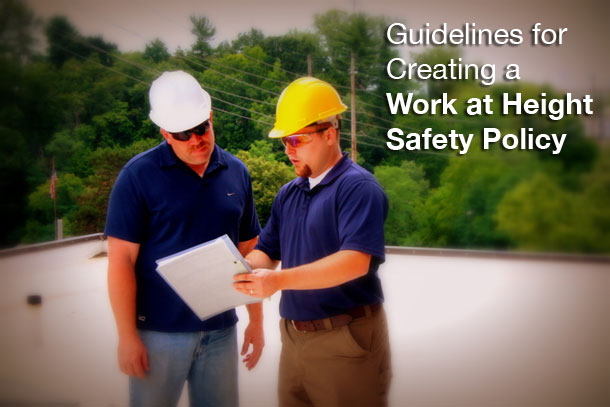Guidelines for Creating a Work at Height Safety Policy

If your company requires employees to work above 4’ in general industry and above 6’ in construction, it is important that you have a policy in place for working at heights. While 4’ and 6’ might not seem all that high, people have died or suffered serious injuries when falling from these levels. Creating a work at heights safety policy can be summed up in a few simple clichés:
This isn’t the Wild West!
You can’t just wing this. You can’t throw some harnesses and lanyards out on a site and hope for the best. You must put a plan in place, train to that plan, and then enforce it. Fall protection regulations can, at times, be complicated for safety professionals to fully understand, let alone employees who only have a passing knowledge of what those regulations are. To expect them to do what is right and what is necessary without the proper guidance is a recipe for disaster.
Besides the danger of physical harm that could befall your employees should you try to operate without a plan, ‘winging it’ won’t pass muster with your friendly regulatory compliance officer. One of the first things the compliance officer will ask during an inspection in which they notice you are working at heights (or that is a result of an incident involving work at heights) is where the relevant sections of your safety policy are and where your training records are. If these are not present, you will most likely be facing citations.
To quote Ben Franklin: “An ounce of prevention is worth a pound of cure!” Get your plan in place and make it effective so that you don’t have to worry about compliance inspections and injured or dead employees.
Start from the beginning!
Starting any task can be daunting, so take the simplest, most common sense approach. First figure out what your fall exposure is. When and where is it likely to occur? What type of work will be performed at heights? What type of equipment will satisfy the requirements, but more importantly, keep your employees safe? Will you be utilizing scaffolds, boom lifts, scissor lifts, or ladders?
There are many details that need to be discerned before writing this plan. Somebody with an understanding of both your operations and the regulatory requirements needs to be involved in this process or things will get missed. If that person doesn’t exist within your organization, you should seek a third-party consultant to assist in the development of this program.
In addition, be sure to determine your Competent Person (and ensure that this employee is aware of his/her designation and that he/she accepts the role) and any requirements that you will have that may go above and beyond what is required by regulation (i.e. – will you have a 6’ fall policy on a construction site which allows for no exceptions to this rule?). These are important details that will help to customize your program.
Do not reinvent the wheel!
You don’t need to write the regulations; they already exist. You already know at what heights fall protection is required. You already know what exceptions to those rules exist. You already know what physical requirements are placed upon the equipment you will need to use and what limitations that same equipment has. Utilize OSHA’s fall protection regulations [29 CFR 1926 Subpart M] as a framework for your program. Remember, though, if a more specific regulation exists for what you do, that regulation overrides the requirements in Subpart M. For example, any fall protection requirements related to Steel Erection in Subpart R override fall protection requirements as outlined in Subpart M.
One way to build your program would be to follow the layout set forth in the CFR: what are some definitions that need to be understood, what is the scope of the program and who does it apply to, and what are your procedures. Keep in mind, while boiler-plate programs can probably be easily found on the web, your program MUST be customized. Utilizing a boiler-plate plan that specifies fall arrest systems as your protection of choice when all of your work at heights takes place about 10’ in the air will do nothing but endanger the employees following your program.
I love it when a plan comes together!
Okay, this isn’t so much a cliché as it is a quote by a lead character in an awesome 80’s television series, but it helps make my final point: you can write a plan and toss it on a shelf, but in order for that plan to come together, your employees must be living it. Not working it. Living it. It needs to be a part of them. It needs to be ingrained into their psyches. It needs to be something they eat, sleep, and breathe because if it’s something they just do because they have to, they won’t do it well.
In order to get to this point, you need to first make sure your employees know exactly what is in the plan. Have they had fall protection training and, if so, did it include a section on your company’s program? If not, that needs to be your first step once the plan is complete. Also, are you enforcing it? Do employees know that if they violate the policy a supervisor might tell them to fix it, but then will just walk away? Remember, most victims of a fall don’t get a chance to say, “Whoops! My mistake! I’ll do better next time!” because there often isn’t a next time.
Research your hazards, solutions, equipment and other regulatory issues. Write your plan. Train to it. Enforce it. Re-evaluate your program and re-train employees when necessary. Then, and only then will your plan come together.


